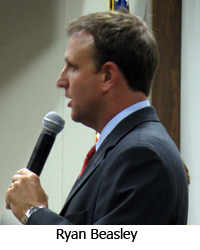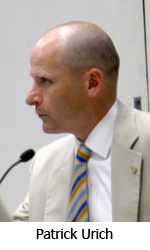A number of agreements regarding the proposed Peoria Riverfront Museum were passed by the Peoria County Board on Thursday. They passed nearly unanimously, with only board members Merle Widmer and Brad Harding voting nay.
The six agenda items pertaining to the museum included an ordinance and five resolutions:
- An ordinance for the issuance of $41,600,000 debt to cover construction expenses for the museum
- A resolutions approving the museum “facilities design concept”
- A resolution approving a $5,040,000 bid from Williams Brothers Construction to building the museum parking deck
- A resolution approving engineering agreements with PSA-Dewberry and Whitney & Associates for “construction oversight and material testing” for the project
- A resolution approving the museum redevelopment agreement
- A resolution approving a Capital Facility Development, Lease and Operating Agreement
 Dave Ransburg and Ryan Beasley (the chair and vice chair of the Peoria Riverfront Museum, respectively) gave presentations on behalf of the Peoria Riverfront Museum. Ransburg stated that this will be the “greatest building built in Peoria since the Civic Center.” He also gave a brief history of how we got to this point, stressing that thousands of hours and millions of dollars have already been spent on this project.
Dave Ransburg and Ryan Beasley (the chair and vice chair of the Peoria Riverfront Museum, respectively) gave presentations on behalf of the Peoria Riverfront Museum. Ransburg stated that this will be the “greatest building built in Peoria since the Civic Center.” He also gave a brief history of how we got to this point, stressing that thousands of hours and millions of dollars have already been spent on this project.
Beasley gave a lengthy presentation, including an update on the IMAX situation. He stated that “it has always been our plan” to deliver a “giant screen” theater with a 70′ x 52′ screen capable of showing 2D and 3D digital, ultra-high definition movies. While that may well have always been their plan, they’ve told the public in no uncertain terms they would be building an IMAX theater, specifically. It’s well documented, even on their own “Build the Block” website.
Beasley went on to say that the museum is “a mission-driven organization,” and that the theater has to fit with their mission, which is “to inspire lifelong learning for ALL, connecting art, history, science and achievement through collections, exhibitions and programs.” In order to do that, the museum has three “negotiating terms”: control over programming, technology, and exclusivity. The biggest obstacle is control over programming. The museum wants to show “classic” (i.e., educational) films during the day and second-run movies on evenings and weekends. That has been IMAX’s traditional model. However, IMAX is apparently interested in seeing their theaters run more first-run movies — what they call “day and date DMR” movies — that would require multiple showings for the first two or three weeks the movie is out. “DMR” is IMAX’s proprietary large-screen film process. The museum’s concern is that agreeing to “day and date DMR” would be more profitable, but violate their mission. They’re also concerned about being required to show some films that are R-rated or otherwise not family-friendly.
The “next steps” for the museum are:
- To “continue preferred IMAX path” — that is, they’re going to continue negotiating with IMAX. Board member Merle Widmer asked about an e-mail one of his constituents received that indicated IMAX “does not have a client interested in opening an IMAX theatre in Peoria.” Beasley stated that was not surprising, given that IMAX received an inquiry from the general public about their “internal operations” — he would expect them to either give no answer, or to answer in the negative. He assured Widmer that he could provide proof of on-going negotiations with IMAX on IMAX letterhead. Media inquiries to IMAX by the Peoria Chronicle have gone unanswered.
- To “continue to evaluate alternative options,” none of which have “the brand power of IMAX,” he admitted.
- To “communicate progress and direction” to everyone, including the County Board and the general public.
 There was another speaker (didn’t catch his name, sorry) who provided an overview of the building and grounds. There will be three “free-standing” signs (they looked like monument signs in the illustration) that would be lighted. Also, on the large blank walls of the museum, there will be humongous banners that can be used for decoration and/or to advertise the movie(s) playing at the “giant screen” theater. The only entrances are the main entrance off of Washington street and the elevator entrance from the parking garage. Thus, most of the area around the museum will be dead space (i.e., there will be no meaningful pedestrian activity outside).
There was another speaker (didn’t catch his name, sorry) who provided an overview of the building and grounds. There will be three “free-standing” signs (they looked like monument signs in the illustration) that would be lighted. Also, on the large blank walls of the museum, there will be humongous banners that can be used for decoration and/or to advertise the movie(s) playing at the “giant screen” theater. The only entrances are the main entrance off of Washington street and the elevator entrance from the parking garage. Thus, most of the area around the museum will be dead space (i.e., there will be no meaningful pedestrian activity outside).
County Administrator Patrick Urich explained that the cost of the project (including the parking deck) has risen from $83.4 million in April 2009, to $87.1 million in February 2010, to $92,198,731 this month. He then went on to talk about various “protections” that are built in to the agreements. For instance, there is $4.3 million in construction contingencies that will not be spent if the bids come in on budget and there are no change orders. There are also fundraising requirements built into the development and lease agreement with the museum: they have to raise $2.5 million by October 2011 and another $2.5 million by October 2012. If they don’t reach this target, then they have to reduce their capital or operating budgets “consistent with the shortfall from the goal.”
This is a marked departure from assurances the County gave to voters before the April 2009 referendum that no construction would start until the money was raised. In the July 9, 2009 Regular County Board Meeting minutes, it states explicitly, “Mr. Urich replied that currently the commitment for private funding is $8,000,000.00. If the funding is not there on the private side, the project will not go forward.” And later in the same meeting, “Mr. Urich has made it clear that ground will not be broken, even for the parking deck, until there is $8,000,000.00 in private funds to cover the gap.” Now, this has been replaced with toothless requirements that money be raised during construction.
Against all evidence to the contrary, everyone seems to be very confident in the museum’s ability to raise additional funds. When asked in a follow-up question about the stall in fundraising, Beasley said that “it’s not as simple as passing the referendum and then the money flows in,” although they did receive some additional funding (he declined to specify how much). Of course, this is exactly what the museum group assured us would happen before the referendum. Then, the only thing holding up donations was the referendum. But now people “want to see shovels in the ground” before they give more money, so we need to start building to get more funds, Beasley said. The target continues to move.
Several board members stated that the agreements weren’t “perfect,” but that they were “very good.” Several board members also stated that they had reservations and concerns about the plans, but not enough to vote against going forward. And there were a lot of self-congratulatory speeches all around as the final votes were taken.

 Dave Ransburg and Ryan Beasley (the chair and vice chair of the Peoria Riverfront Museum, respectively) gave presentations on behalf of the Peoria Riverfront Museum. Ransburg stated that this will be the “greatest building built in Peoria since the Civic Center.” He also gave a brief history of how we got to this point, stressing that thousands of hours and millions of dollars have already been spent on this project.
Dave Ransburg and Ryan Beasley (the chair and vice chair of the Peoria Riverfront Museum, respectively) gave presentations on behalf of the Peoria Riverfront Museum. Ransburg stated that this will be the “greatest building built in Peoria since the Civic Center.” He also gave a brief history of how we got to this point, stressing that thousands of hours and millions of dollars have already been spent on this project. There was another speaker (didn’t catch his name, sorry) who provided an overview of the building and grounds. There will be three “free-standing” signs (they looked like monument signs in the illustration) that would be lighted. Also, on the large blank walls of the museum, there will be humongous banners that can be used for decoration and/or to advertise the movie(s) playing at the “giant screen” theater. The only entrances are the main entrance off of Washington street and the elevator entrance from the parking garage. Thus, most of the area around the museum will be dead space (i.e., there will be no meaningful pedestrian activity outside).
There was another speaker (didn’t catch his name, sorry) who provided an overview of the building and grounds. There will be three “free-standing” signs (they looked like monument signs in the illustration) that would be lighted. Also, on the large blank walls of the museum, there will be humongous banners that can be used for decoration and/or to advertise the movie(s) playing at the “giant screen” theater. The only entrances are the main entrance off of Washington street and the elevator entrance from the parking garage. Thus, most of the area around the museum will be dead space (i.e., there will be no meaningful pedestrian activity outside).